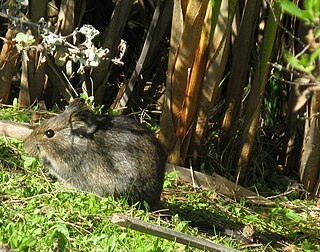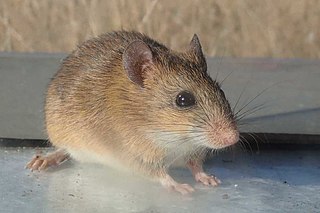
The Muroidea are a large superfamily of rodents, including mice, rats, voles, hamsters, lemmings, gerbils, and many other relatives. Although the Muroidea originated in Eurasia, they occupy a vast variety of habitats on every continent except Antarctica. Some authorities have placed all members of this group into a single family, Muridae, due to difficulties in determining how the subfamilies are related to one another. Many of the families within the Muroidea superfamily have more variations between the families than between the different clades. A possible explanation for the variations in rodents is because of the location of these rodents; these changes could have been due to radiation or the overall environment they migrated to or originated in. The following taxonomy is based on recent well-supported molecular phylogenies.

The Old World rats and mice, part of the subfamily Murinae in the family Muridae, comprise at least 519 species. Members of this subfamily are called murines. In terms of species richness, this subfamily is larger than all mammal families except the Cricetidae and Muridae, and is larger than all mammal orders except the bats and the remainder of the rodents.

Oryzomys is a genus of semiaquatic rodents in the tribe Oryzomyini living in southern North America and far northern South America. It includes eight species, two of which—the marsh rice rat (O. palustris) of the United States and O. couesi of Mexico and Central America—are widespread; the six others have more restricted distributions. The species have had eventful taxonomic histories, and most species were at one time included in the marsh rice rat; additional species may be recognized in the future. The name Oryzomys was established in 1857 by Spencer Fullerton Baird for the marsh rice rat and was soon applied to over a hundred species of American rodents. Subsequently, the genus gradually became more narrowly defined until its current contents were established in 2006, when ten new genera were established for species previously placed in Oryzomys.

The shrewlike rats, genus Rhynchomys, also known as the tweezer-beaked rats are a group of unusual Old World rats found only on the island of Luzon in the Philippines. They look a great deal like shrews and are an example of convergent evolution. Shrewlike rats evolved to be vermivores and insectivores feeding on soft-bodied invertebrates associated with leaf litter.

African vlei rats (Otomys), also known as groove-toothed rats, live in many areas of sub-Saharan Africa. Most species live in marshlands, grasslands, and similar habitats and feed on the vegetation of such areas, occasionally supplementing it with roots and seeds. The name "vlei" refers to the South African term for intermittent, seasonal, or perennial bodies of standing water.

The Tete veld aethomys or Tete veld rat is a species of rodent in the family Muridae. It is found in South Africa and Eswatini. Its natural habitats are temperate forests, shrubland, and grassland. The common name refers to the type locality, Tete, on the Zambesi River.

Fox's shaggy rat is a species of rodent in the family Muridae. It is found only in Nigeria. Its natural habitats are moist savanna, subtropical or tropical seasonally wet or flooded lowland grassland, swampland, and plantations. It is threatened by habitat loss.
The African marsh rat or common dasymys is a species of rodent in the family Muridae. It is found in Angola, Democratic Republic of the Congo, Ethiopia, Kenya, Malawi, South Africa, South Sudan, Tanzania, Uganda, Zambia, and Zimbabwe. Its natural habitats are moist savanna, temperate grassland, subtropical or tropical seasonally wet or flooded lowland grassland, and swamps.

The montane shaggy rat is a species of rodent in the family Muridae. It is found in Uganda and possibly Democratic Republic of the Congo. Its natural habitats are subtropical or tropical moist montane forest, subtropical or tropical high-altitude grassland, and swampland. It is threatened by habitat loss. In terms of appearance it is of moderate size compared to others in its genus Dasymys, with dark grey long, fine, hair. It has a fairly short tail compared to its size.
The Angolan marsh rat is a species of rodent in the family Muridae. It is found in Angola, Botswana, Namibia, and Zambia. Its natural habitats are subtropical or tropical seasonally wet or flooded lowland grassland and swamps. It is threatened by habitat loss.
The West African shaggy rat is a species of rodent in the family Muridae. It is found in Benin, Cameroon, Ivory Coast, Gambia, Ghana, Guinea, Guinea-Bissau, Liberia, Mali, Nigeria, Senegal, Sierra Leone, and Togo. Its natural habitats are subtropical or tropical seasonally wet or flooded lowland grassland and swamps. It is a common species and the International Union for Conservation of Nature has rated its conservation status as being of "least concern".

The Ethiopian amphibious rat, also known as the Ethiopian water mouse, is an insectivorous and semiaquatic species of rodent in the monotypic genus Nilopegamys of the family Muridae. There has only been one known specimen. It was found along the Lesser Abay River near its source at an altitude of 2600 m in the highlands of northwestern Ethiopia in 1928. N. plumbeus is considered to be the most aquatically adapted African murid; its unusually large brain is thought to be one consequence of this lifestyle. The species is considered to be critically endangered or possibly extinct, since its habitat has been severely damaged by overgrazing and monoculture.

The marsh rice rat is a semiaquatic North American rodent in the family Cricetidae. It usually occurs in wetland habitats, such as swamps and salt marshes. It is found mostly in the eastern and southern United States, from New Jersey and Kansas south to Florida and northeasternmost Tamaulipas, Mexico; its range previously extended further west and north, where it may have been a commensal in corn-cultivating communities. Weighing about 40 to 80 g, the marsh rice rat is a medium-sized rodent that resembles the common black and brown rat. The upperparts are generally gray-brown, but are reddish in many Florida populations. The feet show several specializations for life in the water. The skull is large and flattened, and is short at the front.
Glover Allen's dasymys is a species of shaggy marsh rat described in 1953, and indigenous to Mount Rungwe in south-western Tanzania. Contemporary studies of the taxonomy diverge, with the International Union for Conservation of Nature recognising D. alleni as a subspecies of the more widespread D. incomtus, whereas Wilson and Reeder observe the reinstatement of the species as unique in Mammal Species of the World. In their recent analysis, Verheyen et al. describe the distribution of D. alleni as encompassing the Eastern Arc Mountains and the mountainous, volcanic regions around Lake Tanganyika, and potentially the Marungu highlands, in the Democratic Republic of the Congo.
Crawford-Cabral's shaggy rat or Crawford-Cabral's shaggy marsh rat is a species of shaggy marsh rat endemic to north-eastern Namibia, near the Okavango River.
The Rwandan shaggy rat is a species of shaggy marsh rat endemic to north-western Rwanda, close to the Virunga Mountains.
The Tanzanian shaggy rat is a species of shaggy marsh rat endemic to eastern Tanzania, near the Uluguru Mountains.
Robert's shaggy rat is a species of rodent in the genus Dasymys that lives in South Africa. It was described in 2004.

Arvicanthini is a tribe of muroid rodents in the subfamily Murinae. Almost all recent species in this tribe are or were found in Africa aside from one species, the Indian bush rat, which is found in South Asia and Iran. However, some fossil Golunda species from India and the genus Parapelomys are thought to have also occurred outside Africa, and one species in the fossil genus Saidomys may have also occurred in Afghanistan.








